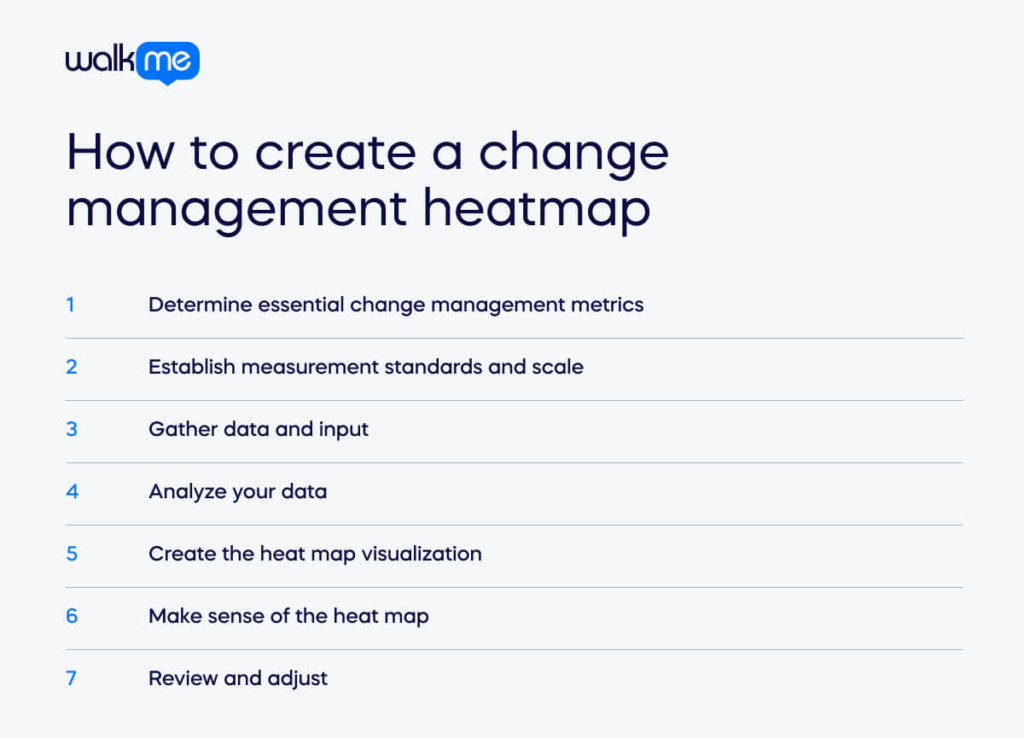Change is as intricate as the human mind because humans are inherently wired to fear it. Therefore, it’s necessary to break it down visually to look at individual parts and how your organization is progressing toward success.
The change management heatmap is a visual display using different colors based on a traffic light system to show how each element of a digital transformation is progressing.
It simplifies all the complicated elements of change management into an easy-to-understand format. This accessible format makes it easier to see where you are succeeding and where work still needs to be done.
The heatmap can help you avoid leading one of the 70% of digital transformations that fail and use the system to lead your organization to success, higher revenue, and better employee retention.
To help you understand the change management heatmap and how to build one, we will explore why you would use one, how to build a heatmap, and its benefits and challenges.
What is a change management heatmap?
A change management heatmap uses the traffic-light color system in a grid format to offer organizations a comprehensive, top-down view of the impact of change initiatives on employees across various teams or business units.
By offering insights into critical impacts over time, it empowers leadership teams within project management teams, including PMOs and CMOs, to make informed decisions on change management strategies that achieve organizational goals while supporting staff.
Why would you use a change management heatmap?
If you already use several change tools and have a team of experts, why would you ever need a change management heatmap?
The change management heatmap can enhance planning and communication, foster engagement, and facilitate decision-making in ways no other tool can. It also bolsters effective change governance, offering a comprehensive view of change impacts with the flexibility for deeper exploration.
The leading reasons that you would use a change management heatmap involve the following elements:
- Visual insight: You need a clear visual representation of a project that impacts personnel, aiding in understanding the extent of change across teams or business units.
- Strategic decision-making: You require empowered leadership teams and project management offices to make informed decisions by highlighting critical impacts over time.
- Resource allocation: A heatmap facilitates the efficient allocation of resources by identifying areas where change management efforts are most needed.
- Risk mitigation: Helps identify potential risks and challenges associated with change initiatives, allowing for proactive mitigation strategies to reduce resistance to change initiatives.
- Stakeholder communication: Enhances stakeholder communication by providing a comprehensive overview of change impacts and progress, fostering transparency and alignment.
Consider these reasons to use a change management heatmap to ensure it is an investment you need to make.
How to create a change management heatmap

The change management heatmap is heavily process-oriented, so using a stepped process to plan how to create and implement your heatmap into your organization to optimize its use on your road to success makes sense.

Following a structured approach to your heatmap is essential, as 47% of organizations that integrate change management increase their chances of meeting objectives.
The first step to creating a heatmap is to define your metrics.
1. Determine essential change management metrics
Identify the critical metrics aligning with your organization’s change initiatives and overarching goals.
These metrics may cover the following:
- Employee experience and engagement.
- Communication efficiency.
- Employee training progress.
- Change resistance and acceptance rates.
- Stakeholder engagement.
Select metrics that offer valuable perspectives on the effectiveness or obstacles of your change efforts.
2. Establish measurement standards and scale
Specify the criteria and scale for measuring each identified metric. Decide whether to collect quantitative or qualitative data and set up a suitable rating system.
Quantitative metrics may utilize numerical scales or Likert-type ratings, while qualitative ones can incorporate experience-based assessments or open-ended responses. This action ensures uniformity and enables precise data depiction on the heatmap.
3. Gather data and input
Acquire data from diverse channels, including surveys, questionnaires, interviews, focus groups, observations, and feedback mechanisms. Develop data collection approaches tailored to gather pertinent information for each metric.
Guarantee that data collection is thorough, dependable, and reflective of the stakeholders engaged in the change journey. Utilize numerical and experience-based data to understand the evolving change landscape comprehensively.
4. Analyze your data
Examine the gathered data to discern patterns, trends, and opportunities for enhancement. Identify correlations, anomalies, and insights uncovered during the analysis.
This stage guides the selection of data points to feature on the heatmap and forms the foundation for decision-making and strategy development. Ensure a comprehensive, impartial analysis that highlights strengths and improvement areas.
5. Create the heat map visualization
Present the data in the format of a heat map. Allocate colors to varying performance or impact levels following the established scale.
Employ a gradient scale, with colors like green denoting high performance, yellow indicating moderate performance, and red highlighting areas necessitating attention or enhancement. Guarantee that the heat map is visually engaging, understandable, and adept at conveying the status of each metric.
6. Make sense of the heat map
Analyze the heat map to extract insights and actionable measures. Pinpoint high-performing sectors as models to emulate—spotlight underperforming zones requiring attention and enhancement.
Examine inter-metric correlations and pinpoint root causes for performance disparities. This analysis informs decision-making and strategy formulation to tackle areas of concern effectively.
7. Review and adjust
Developing a Change Management Heat Map is an ongoing process. It must be regularly revised to mirror evolving circumstances and advancements.
Continuously gather and scrutinize data, revise the heat map with current insights, and monitor the effects of interventions to enhance deficient areas.
This cyclic approach guarantees the heat map’s currency and fosters continual refinement in change management methodologies.
What are the benefits of a change management heatmap?
There are many benefits to the change heatmap, which make it worthy of your consideration for investment as part of efforts to ensure a successful change initiative.
It’s also essential to consider how your employees perceive change, as 18% of employees would consider leaving their employer due to an organizational change. Showing your employees the benefits of change in advance helps them to see change as positive, increasing change initiative outcomes.
The first benefit is improved decision-making:
Improved decision-making
The Change Management Heat Map visually illustrates crucial metrics, empowering stakeholders to make informed choices. A clear and intuitive data presentation fosters a deeper comprehension of the organization’s change dynamics.
Decision-makers can swiftly pinpoint strengths and weaknesses, prioritize actions, and allocate resources efficiently. This tool enriches decision-making by offering a comprehensive perspective on the change journey and facilitating data-driven insights.
Focused interventions
The heatmap illuminates areas necessitating attention or enhancement, enabling organizations to deploy focused interventions. Instead of employing a universal strategy, it identifies precise underperforming metrics or sectors.
This targeted method empowers organizations to concentrate efforts on vital aspects of change management. By directly addressing these areas, organizations can allocate resources, devise interventions, and enact strategies customized to surmount obstacles or improve performance.
Enhanced success in change management
The primary aim of employing a change management heatmap is to elevate the overall success of change management endeavors.
Through consistent monitoring and analysis of essential metrics, organizations acquire insights into the efficacy of their change initiatives. The heatmap facilitates continuous assessment, tracking progress, and pinpointing areas necessitating refinement or enhancement.
Organizations can use this data to adjust their change strategies, fine-tune implementation plans, and preemptively tackle obstacles. Ultimately, the heatmap fosters heightened success rates in change management by offering a structured and visual means to monitor, assess, and enhance the change journey.
Limitations of a change management heatmap
Despite heatmaps having several benefits, they also have limitations that you must consider before investing to allow you to mitigate their negative impact on your change initiative. The first of these limitations involves the fact that the tri-colored traffic light system can mislead some users.
The traffic light system can be misleading
Initially, employing solely three categories to denote different change volumes proves insufficient in organizations experiencing frequent change.
In reality, relying solely on red, amber, and green to represent all degrees of change often results in staff neglecting colors, even amidst the considerable variation. Hence, the depiction of variability within three colors is markedly restrictive.
Psychological bias
Stakeholders expect to decipher traffic light signals. However, stakeholders associate green with positive outcomes, red with alerts or negative implications, and amber with caution or ongoing monitoring within project settings. This interpretation does not align with the intended message of the heatmap.
Each color should indicate the extent of the change’s impact, devoid of suggestions of goodness or badness. An alternative is to use varying shades of the same color to ensure users focus solely on the intensity levels, eliminating additional psychological biases.
Process-driven rigidity
Whether employing three or five levels of colors, the heatmap remains categorical. It categorizes the diverse levels of change into predefined groups. Therefore, by definition, the heatmap lacks granularity.
Its purpose is to offer a broad overview of change volume at a high level. For a more detailed perspective, utilize alternative data expression methods like bar charts to depict precise impact volumes at specific points in time.
What to avoid when building a change management heatmap
Creating a change management heatmap is costly, and you must consider what scenarios to avoid to ensure you don’t waste resources and cause frustration. The first of these scenarios involves communication across all parties before you begin to create a heatmap.
Not communicating with all parties before creating a heatmap
Communication is crucial to saving resources and creating a heatmap everyone will find practical, accessible, and relevant.
Imagine your frustration if you were to build a robust Excel heatmap only for a change manager or project manager to tell you that the configuration should be drastically different to fit their needs or expectations.
Acting on this feedback would involve recreating the entire heatmap, wasting time and money. Avoid this waste by agreeing on the details of the heatmap before creating it.
Avoid poor capture and reporting
Not all key projects get captured, meaning your organization misses out on the impact of the change initiative and loses out on vital learning and value.
Always ensure that you capture all elements of all projects related to the change initiative. You can learn from what works and what doesn’t and share this learning with the change team.
Acquire data analysis expertise
Imagine being part of a team that creates and populates an excellent change heatmap, but you realize you have no experts to analyze the data. This scenario means you cannot reach some decisions you need to make, which delays other stages of the heatmap process.
Ensure you have data analysis expertise before beginning the time and resource-heavy heatmap project. Doing so will save time, money, and frustration later, increasing chances of success as you move smoothly from one stage of creating a heatmap to the next.
Keep a cool head with a change management heatmap
Maintaining clarity amid change is crucial. A change management heatmap offers a structured approach, aiding decision-making and highlighting improvement areas.
Utilize it alongside other tools for a comprehensive understanding and effective management of change.
Many successful change management strategies include heatmaps as part of their arsenal of tools to meet their goals and support their staff throughout the difficult journey of accepting and implementing changes to optimize their use of resources and ensure success.


